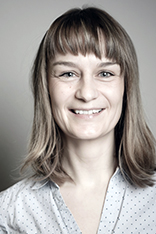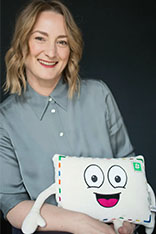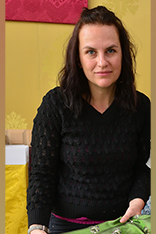Content
"Women in IP" - Chemnitz

This year’s World Intellectual Property Day is dedicated to women: Event though almost half of the world’s population are female, women file significantly fewer patent applications than men, for instance. This needs to be changed, as women’s ingenuity and point of view shape the world. On the occasion of World Intellectual Property Day, the DPMA, together with its cooperation partners, the patent information centres, presents women inventors, designers and trade mark proprietors from all over Germany. The good news is there are many of them and the ideas they have implemented are quite different. Get inspired and join our tour of Germany to discover exciting stories about women in IP. This time we travel to Saxony, more exactly to the region of Chemnitz and its surroundings.
All inventions of this world in one place
See all the inventions of this world in one place - doesn't exist? Yes, there is! At the Patent Information Center Chemnitz. Here - in the middle of Saxony - lies the cradle of the German patent system. In the 19th century, Chemnitz was a world-class industrial city where numerous inventions were made. In order to protect these from imitators, the first mayor and lawyer of the time, Heinrich Friedrich Wilhelm André, and the industrialist Dr. Werner von Siemens were commissioned by the Patent Protection Association they had founded to draw up a draft for a German Imperial Patent Act. This resulted in the first German Imperial Patent Act, which came into force on July 1, 1877. One year later, today's Chemnitz Patent Information Center was founded in 1878, making it one of the oldest patent issuing offices in Germany.
Just 14 years after the German Imperial Patent Act came into force, six times more patent applications were filed in the industrial city of Chemnitz than the national average. The inventive spirit in Chemnitz and the region remains unbroken to this day. The fact that there are also many innovative and creative women among them is demonstrated by the entrepreneurs Dr. Karin Weigelt, Yvonne Heim and Peggy Wunderlich. They are representative of many female inventors from the Saxon region in and around Chemnitz.
The head of the ![]() Patent Information Center Chemnitz, Dr. Carina Gerlach, is optimistic that there will be even more female inventors in the future: "I would like to see the importance of intellectual property rights being taught more intensively not only in university and professional life, but already in school. That is why we - the team at PIZ Chemnitz - not only support companies, universities, research institutions, founders and freelance inventors by providing comprehensive information on industrial property rights, conducting searches, providing training and arranging free initial consultations for inventors, but also visit schools to inform them about the possibilities of industrial property rights. After all, today's young people are tomorrow's inventors."
Patent Information Center Chemnitz, Dr. Carina Gerlach, is optimistic that there will be even more female inventors in the future: "I would like to see the importance of intellectual property rights being taught more intensively not only in university and professional life, but already in school. That is why we - the team at PIZ Chemnitz - not only support companies, universities, research institutions, founders and freelance inventors by providing comprehensive information on industrial property rights, conducting searches, providing training and arranging free initial consultations for inventors, but also visit schools to inform them about the possibilities of industrial property rights. After all, today's young people are tomorrow's inventors."
Printed electronics for secure, interactive documents
Karin Weigelt's invention is more than worthy of an award - she received both the ![]() "Sächsischen Gründerinnenpreis" and the "women&work Erfinderinnenpreis". Her patented prismaID technology equips printed products with an environmentally friendly, electronic interface to smartphones, thus enabling access from physical products to digital services. The electronic components are printed onto documents or labels using electrically conductive ink. The technology does not require any chips or batteries and is fully recyclable.
"Sächsischen Gründerinnenpreis" and the "women&work Erfinderinnenpreis". Her patented prismaID technology equips printed products with an environmentally friendly, electronic interface to smartphones, thus enabling access from physical products to digital services. The electronic components are printed onto documents or labels using electrically conductive ink. The technology does not require any chips or batteries and is fully recyclable.
The technology is designed for high scalability. This means customers can integrate the technology into their products and develop digital applications, for example in the field of document security or "consumer engagement.
Property right applications/property rights
- EP 3 355 246 B1 and EP 3 577601 B1 Method for generating a time-dependent signal on a capacitive surface sensor and a method for identifying a card-like object, and a card-like object and its use
- EP 3 259 660 B1 Self-grounding capacitive information carrier and its use
- EP 3 577 595 B1 Device and its use for generating a time-dependent signal on a capacitive area sensor, and an electrically conductive structure for such a device
- EP 3 007 109 B1 Data carrier with improved detection accuracy due to a multilayer structure of the information carrier
- EP 3 201 824 B1 Reduced ink coverage of printed electronic designs by alternative fill patterns with beam and grid patterns and further
"Lucky Letter" - Making children happy
What makes for a happy life? Yvonne Heim first asked herself this question for her son. Does a child really need big "plastic gift piles" or aren't there other - intangible - values that are much more important? Finally, Yvonne Heim created a tool for parents that enables them to build a foundation for a good life: "Lucky Letter" opens up this space for children and reminds parents and grandparents of what really counts in life.
How it works. Over a period of 12 months, a child - aged between five and nine - receives a letter (= "Lucky Letter") every month. Together with their parents, they learn stories about Franz's mistakes, Doris's gratitude, Lia's boredom, Nala's nature and Fanny's friendship. At the beginning, the child also receives a "Lucky Letter" plush figure, handmade and design-protected in Thuringia, in which he or she can collect all the letters and with which the family can, of course, also cuddle together.
Property right applications/property rights
- Trademark 3020212011094 Lucky Letter
- Design 402021200127-0001 - Plush figure
- Design 402021200127-0002 - Envelopes
- Design 402021200127-0003 - Envelopes
- Design 402021200127-0004 – Envelopes
All the threads in the hand - from traditional fabrics to the glass factory
Founder Peggy Wunderlich, head of "STW Sächsische Textilwerke GmbH", manufactures traditional silk wall coverings as well as decorative fabrics for historical furniture, curtains with patterns typical of the era and for furnishing exclusive rooms, cars and yachts. Fabrics designed more than 100 years ago by famous designers can be faithfully reproduced using textile technology according to today's requirements. Customer orders come from all over the world.
Peggy Wunderlich not only holds all the strings, she is also in the process of planning a glass factory. She, too, is a winner of the "Saxon Founders' Prize".
Property right applications/property rights
- Trademark DE 302015059774 Cammann Gobelin Manufaktur
- Trademark DE 302021226334 SEIDENMANUFAKTUR ESCHKE
- Trademark DE 303491493 eschke
You can view all property right documents in DPMAregister.
Bild 1: WIPO, Bild 2: Marko Illing, Bild 3 + 4: privat
Last updated: 16 April 2025


 more information on the website of the Prismade Labs GmbH
more information on the website of the Prismade Labs GmbH


Not only protecting innovations
Social Media